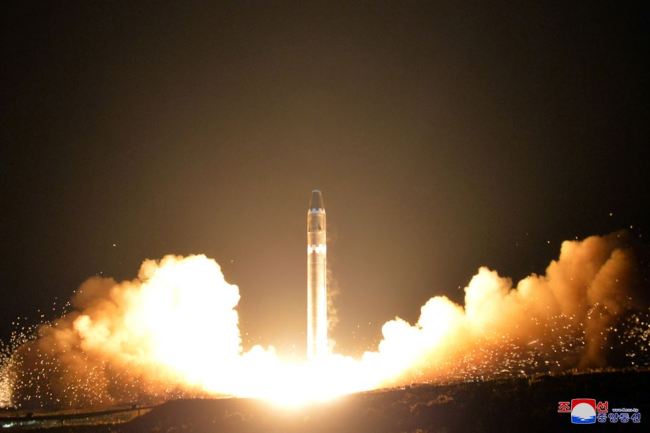US President Donald Trump’s indication of some flexibility in the timetable for dismantling North Korea’s nuclear program is fueling speculations that a “Trump model” of denuclearization might be taking shape.
In his meeting with South Korean President Moon Jae-in in Washington, Trump noted that “all- in-one would be nice” in North Korean denuclearization, but hinted at some leeway on the matter.
 |
North Korea test-launched the Hwasong-15 missile in November 2017. (KCNA-Yonhap) |
“I don’t think I want to totally commit myself but all-in-one would be a lot better,” Trump said.
“Or at least for physical reasons over a very short period of time. You know you do have some physical reasons that it may not be able to do exactly that. So for physical reasons over a very short period of time. Essentially that would be all-in-one.
Trump’s hint of flexibility came on the heels of North Korea’s threats to cancel the unprecedented summit between Trump and North Korean leader Kim Jong-un scheduled for June in Singapore.
The US and North Korea have been struggling to close the gap in their perceptions of denuclearization. The US has been pushing for the complete, verifiable and irreversible dismantlement of the North’s nuclear weapons program, while the North has been calling for a “phased and synchronous” approach.
In recent months, Trump’s hawkish national security adviser John Bolton has advocated the Libyan model, which calls for a quick dismantlement of North Korea’s nuclear program with no guarantee of benefits to the regime in the process. North Korea has objected to the model, citing the downfall of Libyan President Muammar Gaddafi less than a decade after the African nation’s voluntary disarmament in 2003.
But Trump recently contradicted Bolton, reiterating his administration’s stance that it does not seek a regime change in North Korea.
“Trump’s latest remarks about an ‘all-in-one’ approach differs from the US’ previous model that calls for the surrender of the entire nuclear infrastructure before granting incentives,” said Kim Dong-yub, a professor at Kyungnam University’s Far East Institute.
“It would be realistic to say that North Korea’s denuclearization process would be a combination of the North’s phased and synchronous approach and the US’ offer of rewards corresponding with the North’s respective steps toward nuclear dismantlement,” he added.
The Seoul-based expert explained that the speedy verification of the denuclearization process, coupled with a compressed timeline of achieving the denuclearization goal, is what Trump is fundamentally focusing on, as he aims to bring about noteworthy results before the end of his term in 2020.
While the agreement itself might be reached swiftly, the implementation of the agreement would be carried out in phases, experts noted.
“The US seeks complete denuclearization while North Korea wants a regime security, so both sides are expected to make an all-in-one agreement, then cooperate step-by-step regarding the implementation of the agreement,” said Yang Moo-jin, a professor at the University of North Korean Studies.
There were signs that Washington is mapping out a new model for North Korea, as White House press secretary Sarah Huckabee mentioned a “Trump model” for the first time earlier this month, without elaborating.
By Jung Min-kyung (
mkjung@heraldcorp.com)








